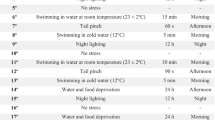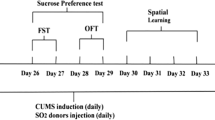Abstract
Epidemiological studies have implicated copper as one of the key environmental risk factors for the pathogenesis of depression. However, the precise mechanism by which copper contribute to the genesis of depression particularly the involvement of oxidative stress-driven neuroinflammation is yet to be fully investigated. Thus, this study was designed to evaluate the effects of copper sulfate (CuSO4) on depression-like behaviors and the role of oxidative stress and pro-inflammatory cytokines in mice. Forty male Swiss mice were distributed into control and three test groups (n = 10), and were treated orally with distilled water (10 mL/kg) or CuSO4 (25, 50 and 100 mg/kg) daily for 28 days. Afterwards, the tail suspension, forced swim, and sucrose splash tests were used for the detection of depression-like effects. The animals were then euthanized and the brains were processed for the estimation of biomarkers of oxidative stress and pro-inflammatory cytokines (tumor necrosis factor-alpha and interleukin-6). The histomorphological features and neuronal viability of the prefrontal cortex, hippocampus and striatum were also determined. Mice exposed to CuSO4 displayed depression-like features when compared with controls. The brain concentrations of malondialdehyde, nitrite and pro-inflammatory cytokines were elevated in CuSO4-treated mice. Mice exposed to CuSO4 also had reduced brain antioxidant status (glutathione, glutathione-s-transferase, total thiols, superoxide-dismutase and catalase), as well as altered histomorphological features, and decreased population of viable neuronal cells. These findings suggest that CuSO4 increases oxidative stress and pro-inflammatory cytokines to elicit depression-like effects in mice.









Similar content being viewed by others
Availability of data and materials
The authors declare that the databases that support the results will be available when requested from the corresponding author.
References
Adebesin A, Adeoluwa OA, Eduviere AT, Umukoro S (2017) Methyl jasmonate attenuated lipopolysaccharide-induced depressive-like behaviour in mice. J Psychiatr Res 94:29–35. https://doi.org/10.1016/j.jpsychires.2017.06.007
Bakunina N, Pariante CM, Zunszain PA (2015) Immune mechanisms linked to depression via oxidative stress and neuroprogression. Immunol 144:365e373. https://doi.org/10.1111/imm.12443
Bandmann O, Weiss KH, Kaler SG (2015) Wilson’s disease and other neurological copper disorders. Lancet Neurol 14:103–113. https://doi.org/10.1016/S1474-4422(14)70190-5
Cathomas F, Hartmann MN, Seifritz E, Pryce CR, Kaiser S (2015) The translational study of apathy-an ecological approach. Front Behav Neurosci 9:241. https://doi.org/10.3389/fnbeh.2015.00241
Coelho FC, Cerchiaro G, Araújo SES, Daher JPL, Cardoso SA, Coelho GF, Guimarães AG (2022) Is there a connection between the metabolism of copper, sulfur, and molybdenum in Alzheimer’s Disease? New insights on disease etiology. Int J Mol Sci. 23:7935. https://doi.org/10.3390/ijms23147935
Crayton JW, Walsh WJ (2007) Elevated serum Cu levels in women with a history of post-partum depression. J Trace Elem Med Biol 21:17–21. https://doi.org/10.1016/j.jtemb.2006.10.001
Dantzer R, O’Connor JC, Freund GG, Johnson RW, Kelley KW (2008) From inflammation to sickness and depression: when the immune system subjugates the brain. Nat Rev Neurosci 9:46e54. https://doi.org/10.1038/nrn2297
d’Audiffret AC, Frisbee SJ, Stapleton PA, Goodwill AG, Isingrini E, Frisbee JC (2010) Depressive behavior and vascular dysfunction: a link between clinical depression and vascular disease?. Appl Physiol 108:1041–1051. https://doi.org/10.1152/japplphysiol.01440.2009
Desai V, Kaler SG (2008) Role of copper in human neurological disorders. Am J Clin Nutr 88:855S-858S. https://doi.org/10.1093/ajcn/88.3.855S
Ellman GL (1959) Tissue sulfhydryl groups. Arch Biochem Biophys 82:70–77. https://doi.org/10.1016/0003-9861(59)90090-6
Emokpae O, Ben-Azu B, Ajayi AM, Umukoro S (2020) D-Ribose-L-cysteine attenuates lipopolysaccharide-induced memory deficits through inhibition of oxidative stress, release of proinflammatory cytokines, and nuclear factor-kappa B expression in mice. Naunyn-Schmied Arch Pharm 393:909–925. https://doi.org/10.1007/s00210-019-01805-0
Etebary S, Nikseresht S, Sadeghipour HR, Zarrindast MR (2010) Postpartum depression and role of serum trace elements. Iran J Psychiat 5:40–46
Girgis F, Pace J, Sweet J, Miller JP (2016) Hippocampal neurophysiologic changes after mild traumatic brain injury and potential neuromodulation treatment approaches. Front Syst Neurosci 2016| https://doi.org/10.3389/fnsys.2016.00008
Goth LA (1990) Simple method for determination of serum catalase activity and revision of reference range. Clin Chim Acta 196:143–151. https://doi.org/10.1016/0009-8981(91)90067-m
Green LC, Tannenbaum SR, Goldman P (1981) Nitrate synthesis in the germ free and conventional rat. Science 212:56–58. https://doi.org/10.1126/science.6451927
Grubman A, White AR (2014) Copper as a key regulator of cell signalling pathways. Expert Rev Mol Med 22: https://doi.org/10.1017/erm.2014.11
Habig WH, Jakoby WB (1981) Assay for differentiation of glutathione-S-transferases. Meth Enzymol 77:398–405. https://doi.org/10.1016/s0076-6879(81)77053-8
Isibor H, Ajayi AM, Ben-Azu B, Omeiza NA, Ademola AP, Umukoro S (2022) D-Ribose-L-Cysteine reduces oxidative stress and inflammatory cytokines to mitigate liver damage, and memory decline induced by copper sulfate in mice. J Trace Elements in Med Biol 73:12700. https://doi.org/10.1016/j.jtemb.2022.127001
Jollow DJ, Mitchell JR, Zampaglione N, Gillette JR (1974) Bromobenzene-induced liver necrosis. Protective role of glutathione and evidence for 3, 4-bromobenzene oxide as the hepatotoxic metabolite. Pharmacol 11:151–169. https://doi.org/10.1159/000136485
Kaczmarek AT, Strampraad MJF, Hagedoorn PL, Schwarz G (2019) Reciprocal regulation of sulfite oxidation and nitrite reduction by mitochondrial sulfite oxidase. Nitric Oxide 89:22–31. https://doi.org/10.1016/j.niox.2019.04.004
Kalita J, Kumar V, Misra UK, Bora HK (2020) Movement disorder in copper toxicity rat model: Role of inflammation and apoptosis in the corpus striatum. Neurotox Res 37:904–912. https://doi.org/10.1007/s12640-019-00140-9
Kułak-Bejda A, Waszkiewicz N, Galińska-Skok B, Zajkowska A, Kułakowska A, Kochanowicz J (2020) Primarily depression manifestation of Wilson’s disease-case report. Clin Neurol Neurosurg 190:105651. https://doi.org/10.1016/j.clineuro.2019.105651
Leonard B, Maes M (2012) Mechanistic explanations how cell-mediated immune activation, inflammation and oxidative and nitrosative stress pathways and their sequels and concomitants play a role in the pathophysiology of unipolar depression. Neurosci Biobehav Rev 36:764–785. https://doi.org/10.1016/j.neubiorev.2011.12.005
Liao X, Lai S, Zhong S, Wang Y, Zhang Y, Shen S, Huang H, Chen G, Chen F, Jia Y (2021) Interaction of serum copper and neurometabolites on executive dysfunction in unmedicated patients with major depressive disorder. Front Psychiat 12:564375. https://doi.org/10.3389/fpsyt.2021.564375
Litwin T, Dusek P, Szafrański T, Dzieżyc K, Członkowska A, Rybakowski JK (2018) Psychiatric manifestations in Wilson’s disease: possibilities and difficulties for treatment. Ther Adv Psychopharmacol 8:199–211. https://doi.org/10.1177/2045125318759461
Liu L, Zhang O, Cai Y, Sun D, He X, Wang L, Yu D, Li X, Xiong X, Xu H, Yang O, Fan X (2016) Resveratrol counteracts lipopolysaccharide-induced depressive-like behaviors via enhanced hippocampal neurogenesis. Oncotarget 7:56045–56059. https://doi.org/10.18632/oncotarget.11178
Liu X, Zhong S, Li Z, Chen J, Wang Y, Lai S, Miao H, Jia Y (2020) Serum copper and zinc levels correlate with biochemical metabolite ratios in the prefrontal cortex and lentiform nucleus of patients with major depressive disorder. Prog Neuropsychopharmacol Biol Psychiat 99:109828. https://doi.org/10.1016/j.pnpbp.2019.109828
Lowry OH, Rosenbrough NJ, Farr AL, Randall RJ (1951) Protein measurement with Folin phenol reagent. J Biol Chem 193:265–275. https://doi.org/10.1016/S0021-9258(19)52451-6
Maes M, Vandoolaeghe E, Neels H, Demedts P, Wauters A, Meltzer HY, Altamura C, Desnyder R (1997) Lower serum zinc in major depression is a sensitive marker of treatment resistance and of the immune/inflammatory response in that illness. Biol Psychiat 42:349–358. https://doi.org/10.1016/S0006-3223(96)00365-4
Maes M, Galecki P, Chang YS, Berk M (2011) A review on the oxidative and nitrosative stress (ONS) pathways in major depression and their possible contribution to the (neuro) degenerative processes in that illness. Prog Neuro-Psychopharmacol Biol Psychiatry 35:676–692. https://doi.org/10.1016/j.pnpbp.2010.05.004
Manser WW, Khan MA, Hasan KZ (1989) Trace element studies on Karachi population. Part IV: blood copper, zinc, magnesium and lead levels in psychiatric patients with depression, mental retardation and seizure disorders. J Pak Med Assoc 39:269–274
Miller AM, Maletic V, Raison CL (2009) Inflammation and its discontents: the role of cytokines in the pathophysiology of major depression. Biol Psychiat 65:732–741. https://doi.org/10.1016/j.biopsych.2008.11.029
Misra P, Fridovich I (1972) The role of superoxide anion in the autooxidation of epinephrine and a simple assay for superoxide dismutase. J Biol Chem 247:3170–3175. https://doi.org/10.1016/S0021-9258(19)45228-9
Młyniec K, Gaweł M, Doboszewska U, Starowicz G, Pytka K, Davies CL, Budziszewska B (2015) Essential elements in depression and anxiety. Part II Pharmacol Rep 67:187–194. https://doi.org/10.1016/j.pharep.2014.09.009
Narang RL, Gupta KR, Narang AP, Singh R (1991) Levels of copper and zinc in depression. Indian J Physiol Pharmacol 35:272–274
O’Connor JC, Lawson MA, Andre C, Moreau M, Lestage J, Castanon N, Kelley KW, Dantzer R (2009) Lipopolysaccharide-induced depressive-like behavior is mediated by indoleamine 2,3-dioxygenase activation in mice. Mol Psychiatr 14:511–522. https://doi.org/10.1038/sj.mp.4002148
Ohkawa H, Ohishi N, Yagi K (1979) Assay for lipid peroxides in animal tissues by thiobarbituric acid reaction. Anal Biochem 95:351–358. https://doi.org/10.1016/0003-2697(79)90738
Planchez B, Surget A, Belzung C (2019) Animal models of major depression: drawbacks and challenges. J Neural Transmission 126:1383–1408. https://doi.org/10.1007/s00702-019-02084-y
Porsolt RD, Anton G, Deniel M (1978) Behavioral despair in rats: a new animal model sensitive to antidepressant treatments. Eur J Pharmacol 47:379–391. https://doi.org/10.1016/0014-2999(78)90118-8
Pulai S, Biswas A, Roy A, Guin DS, Pandit A, Gangopadhyay G, Kumar P, Ghorai KP, SujitSarkhel S, Senapati AK (2014) Clinical features, MRI brain, and MRS abnormalities of drug-naive neurologic Wilson’s disease. Neurol India 62:153–158. https://doi.org/10.4103/0028-3886.132349
Russo AJ (2011) Analysis of plasma zinc and copper concentration, and perceived symptoms, in individuals with depression, post-zinc and anti-oxidant therapy. Nutr Metab Insights 17:19–27. https://doi.org/10.4137/NMI.S6760
Scheiber IF, Mercer JF, Dringen R (2014) Metabolism and functions of copper in brain. Prog Neurobiol 116:33–57. https://doi.org/10.1016/j.pneurobio.2014.01.002
Schlegel-Zawadzka M, Nowak G (2000) Alterations in serum and brain trace element levels after antidepressant treatment. Part II: copper. Biol Trace Elem Res 73:37–45. https://doi.org/10.1385/BTER:73:1:37
Schlegel-Zawadzka M, Zieba A, Dudek D, Zak-Knapik J, Nowak G (1999) Is serum copper a “trait marker” of unipolar depression?, A preliminary clinical study. Pol J Pharmacol 51:535–538
Steru L, Chermat R, Thierry B, Simon P (1985) The tail suspension test: a new method for screening antidepressants in mice. Psychopharmacol (berl) 85:367–370. https://doi.org/10.1007/BF00428203
Styczeń K, Sowa-Kućma M, Siwek M, Dudek D, Reczyński W, Misztak P, Szewczyk R, Topór-Mądry B, Opoka W, Nowak G (2016) Study of the serum copper levels in patients with major depressive disorder. Biol Trace Elem Res. 174:287–293. https://doi.org/10.1007/s12011-016-0720-5
Stys PK, You H, Zamponi GW (2012) Copper dependent regulation of NMDA receptors by cellular prion protein: implications for neurodegenerative disorders. J Physiol 590:1357–1368. https://doi.org/10.1113/jphysiol.2011.225276
Tonnies E, Trushina E (2017) Oxidative stress, synaptic dysfunction, and Alzheimer’s disease. J Alzheimer’s Dis 57:1105–1121. https://doi.org/10.3233/JAD-161088
Vavakov M, Durackova Z, Trebatick I (2015) Markers of oxidative stress and neuroprogression in depression disorder. Oxidative Med Cell Longev (2015) Article ID 898393, 12 pages https://doi.org/10.1155/2015/898393
Zou J, Wang W, Pan YW, Abel GM, Storm DR, Xia Z (2015) Conditional inhibition of adult neurogenesis by inducible and targeted deletion of ERK5 MAP kinase is not associated with anxiety/depression-like behaviors. eNeuro 2 (2015) https://doi.org/10.1523/eneuro.0014-14.2015
Acknowledgements
Authors are grateful to the technical staff of the Department of Pharmacology and Therapeutics, University of Ibadan for their assistance.
Funding
The authors declare that no funds, grants, or other support were received during the preparation of this manuscript.
Author information
Authors and Affiliations
Contributions
SU, AMA and PAA conceived and designed research. AMA and PAA conducted experiments. SU and BB analyzed and interpreted data. SU and AMA wrote the manuscript. All authors read and approved the manuscript. The authors declare that all data were generated in-house and that no paper mill was used.
Corresponding author
Ethics declarations
Ethical approval
The experimental procedures were approved by the University of Ibadan Animal Care and Use Research Ethics Committee (UI-ACUREC/070–0721/23).
Competing interests
The authors have no relevant financial or non-financial interests to disclose.
Additional information
Publisher's Note
Springer Nature remains neutral with regard to jurisdictional claims in published maps and institutional affiliations.
Rights and permissions
Springer Nature or its licensor (e.g. a society or other partner) holds exclusive rights to this article under a publishing agreement with the author(s) or other rightsholder(s); author self-archiving of the accepted manuscript version of this article is solely governed by the terms of such publishing agreement and applicable law.
About this article
Cite this article
Adeleke, P.A., Ajayi, A.M., Ben-Azu, B. et al. Involvement of oxidative stress and pro-inflammatory cytokines in copper sulfate-induced depression-like disorders and abnormal neuronal morphology in mice. Naunyn-Schmiedeberg's Arch Pharmacol 396, 3123–3133 (2023). https://doi.org/10.1007/s00210-023-02519-0
Received:
Accepted:
Published:
Issue Date:
DOI: https://doi.org/10.1007/s00210-023-02519-0




